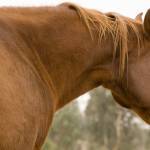Searching for Biomarkers of Dysbiosis and Leaky Gut Syndrome in Horses

Imagine that your horse’s skin is composed of a single microscopic layer of cells. Any trauma or irritation would damage this layer of cells with devastating consequences. In reality, though, the skin is thick, and adjacent cells and connective tissues keep everything beneath it in place.
If only the intestinal tract was designed the same way! Instead, only one layer of cells separates the contents of the intestinal tract—where digesta and microorganisms mingle—from the blood vessels that absorb nutrients and circulate them throughout the horse’s body.
“When that layer of cells is damaged or when the tight junctions between individual intestinal cells become leaky, more than just nutrients can cross into the bloodstream. Bacteria, food particles, and even toxins gain direct access to the circulatory system,” explained Kathleen Crandell, Ph.D., a nutritionist for Kentucky Equine Research.
The consequences of intestinal barrier dysfunction, also called leaky gut syndrome, can be serious and include weight loss, behavior changes, poor performance, systemic inflammatory response syndrome, multiple organ dysfunction syndrome, and death.
“Horses with leaky gut syndrome have altered intestinal microbiomes, which is referred to as dysbiosis. But whether the dysbiosis causes intestinal barrier dysfunction or inflammation of the intestinal barrier causes dysbiosis remains unclear,” Crandell said.
Analyzing samples of the intestinal microbiome and intestinal lining biopsies would likely answer that question quickly; however, obtaining those samples in live horses is impossible. In lieu of biopsies, noninvasive biomarkers of intestinal barrier function would be invaluable.
French researchers recently suggested that lipopolysaccharide (LPS) found in the bloodstream could be a useful marker in determining gut health.* LPS is a component of the cell walls of bacteria, such as the normal, beneficial bacteria found in a healthy intestinal microbiome. In the case of leaky gut, LPS molecules from bacteria could translocate across the intestinal barrier into the bloodstream where they can be measured.
To test this theory, dysbiosis was induced in horses using two distinct microbiota stressors: antibiotic (trimethoprim sulfadiazine) administration and an abrupt dietary change from a high-fiber to a high-starch diet. The diets were offered for five days. Blood and fecal samples were collected on days 0, 2, 7, 14, and 28. LPS was measured in the blood, and fecal samples were analyzed to assess the intestinal microbiomes.
“Dysbiosis was observed in both groups of horses by day 7 of the study, affirming that the abrupt diet change and antibiotic dosing disrupted the intestinal microbiome, which indicates that the intestinal permeability was compromised,” Crandell explained. “With this result, blood biomarkers such as LPS may, with further development, prove to be useful tools for identifying horses with leaky gut syndrome.”
Regardless of whether dysbiosis is the cause or consequence of leaky gut, a healthy microbiome must be re-established as quickly as possible. Kentucky Equine Research offers several products designed for optimizing the health of the horse’s gastrointestinal tract. These include hindgut buffers such as EquiShure that stabilizes the pH, warding off subclinical acidosis that can contribute to dysbiosis.
*Collinet, A., P. Grimm, E. Jacotot, and V. Julliand. 2022. Biomarkers for monitoring the equine large intestinal inflammatory response to stress-induced dysbiosis and probiotic supplementation. Journal of Animal Science 100(10).








